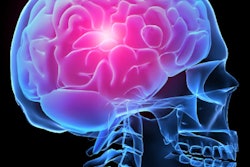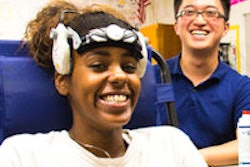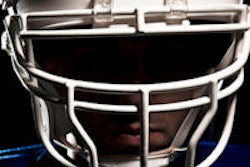
SAN FRANCISCO - Brain changes resulting from traumatic brain injury (TBI) are measurable on MRI after just one season of high school football, even if the athletes never experienced a concussion, according to a study presented on Tuesday at the American Association of Neurological Surgeons (AANS) meeting.
Researchers from Wake Forest and Virginia Tech universities performed diffusion-tensor MRI (DTI-MRI) and gathered impact data on 27 high school football players before and after a single football season. By using MRI with information from sensors mounted inside football helmets, they found that changes in white-matter integrity on MRI correlated significantly with the cumulative impact of hits to the head -- as well as with changes in the players' cognitive performance.
"The kids that got hit harder often had more changes to their brain in white-matter integrity," said Dr. Alexander Powers, the study's principal investigator and a neurosurgeon at Wake Forest Baptist Health.
Football a major source of TBI
Roughly 3 million sports-related concussions occur in the U.S. each year, and football is the most common cause because it is a direct-impact sport, according to Powers. Fortunately, because there are helmets involved, there are also opportunities to measure traumatic brain injury, he said.
Most studies to date have looked at professional players in the National Football League (NFL). However, young people's head injuries are perhaps even more critical a topic because of the large number of young athletes, and because brains undergo major changes during the first two decades of life. Studying the impact of hits during these critical years can reveal details about the relationship between collisions and future brain health, as well as inform society about the best ways to minimize the possibility of injury.
Recently, McAllister et al showed that contact athletes performed worse on neurocognitive tests than athletes in noncontact sports such as swimming and running, Powers said. In another study, Breedlove and colleagues correlated pre- and postseason changes on functional MRI scans with the number of head blows and functional impairment; however, impact measurements were crude.
Ongoing study of young football players
The present study is a joint effort between Wake Forest University and Virginia Polytechnic Institute and State University. Year 2 of the ongoing study has just been completed; Powers presented the first year's data at this week's AANS meeting.
In total, Powers and colleagues looked at six football teams with players ages 6 to 18 years. They measured impact by placing accelerometers in each helmet and capturing every hit for an entire football season, including both practices and games. The data presented were from 27 individuals on a football team of 40 players, with an average age of 17 years (range, 15.8 to 18.5 years).
The accelerometers were part of the Head Impact Telemetry System (HITS), a software system that measures cumulative impact by force. The researchers measured total impacts and a factor called risk-weighted cumulative exposure (RWE) calculated from the helmet sensor data for each football player. DTI-MRI data were also computed and analyzed as normal or abnormal.
Sophisticated risk assessment
Previous studies have been based on a cruder way of measuring impact known as the summed acceleration method, which doesn't account for the fact that greater impact leads to higher risk, which has been demonstrated in the literature, Powers said.
Comparing impacts and cumulative exposure is fraught with potential inaccuracies because "not all impacts are created equal," he noted. "Five hundred impacts for one player ... might be different from 500 impacts for another player. It's all based on position, weight, and so forth."
Cumulative risk assessment can be used to calculate the probable harmful effects caused by simultaneous or sequential exposure to multiple environmental impacts, Powers explained. In calculating impact from the HITS device, the researchers included summed linear and rotational acceleration experienced by each athlete. The RWE factor represents the summed risk associated with each player for the season.
Weighting impacts according to risk provides a more comprehensive look at player-specific exposure, and RWE can be correlated with imaging and neurocognitive data. "The athletes with the highest number of impacts don't necessarily have the greatest RWE," Powers said.
Among the 40 football players at Reagan High School in Pfafftown, NC, who wore the HITS apparatus in their helmets, a total of 16,507 impacts were measured during the season, with a median g-force of 21.9.
The researchers' primary hypothesis was that they would find an association between RWE and fractional anisotropy (FA) on MRI scans. Secondary analyses were also performed to characterize associations between the separate biomechanical metrics of RWE, as well as other DTI measures. The researchers constructed a linear regression model for cumulative RWE and FA, using the number of abnormal FA voxels as the dependent variable.
Linear relationship
Impact was weighted according to the combined probability (RWE-CP) of head injury due to both linear and rotational acceleration, as well as using linear acceleration and rotational acceleration alone. In the 27 athletes, the results showed a statistical linear relationship between RWE-CP and DTI-MRI scans classified as abnormal.
"We all kind of took a step back and said, 'Wow,' " Powers said.
The athletes with the greatest cumulative exposure had the most significant white-matter changes at MRI. At the same time, RWE rotational data and the total number of head impacts did not demonstrate a statistically significant association with any of the DTI data.
The results show that a single season of football can produce brain MRI changes in the absence of concussion, Powers said. Similar brain changes have previously been associated with mild traumatic brain injury.
Commenting on the study after Powers' talk, Dr. Julian Bailes from the NorthShore Neurological Institute said the researchers broke new ground in finding that brain "changes were measurable without concussion symptoms."
The study has limitations due to its small study cohort, and questions remain about the accuracy of HITS for measuring impact, Bailes said. In addition, concussions occur over a wide range of impact magnitudes, their thresholds are dynamic over time, and it's important to remember that concussion thresholds are not affected by the cumulative effects of ongoing impacts.
"The conclusion is that you can have MRI abnormalities without a known concussion -- a bit of a specter, perhaps, a bit of emerging science," Bailes said.



.fFmgij6Hin.png?auto=compress%2Cformat&fit=crop&h=100&q=70&w=100)




.fFmgij6Hin.png?auto=compress%2Cformat&fit=crop&h=167&q=70&w=250)











